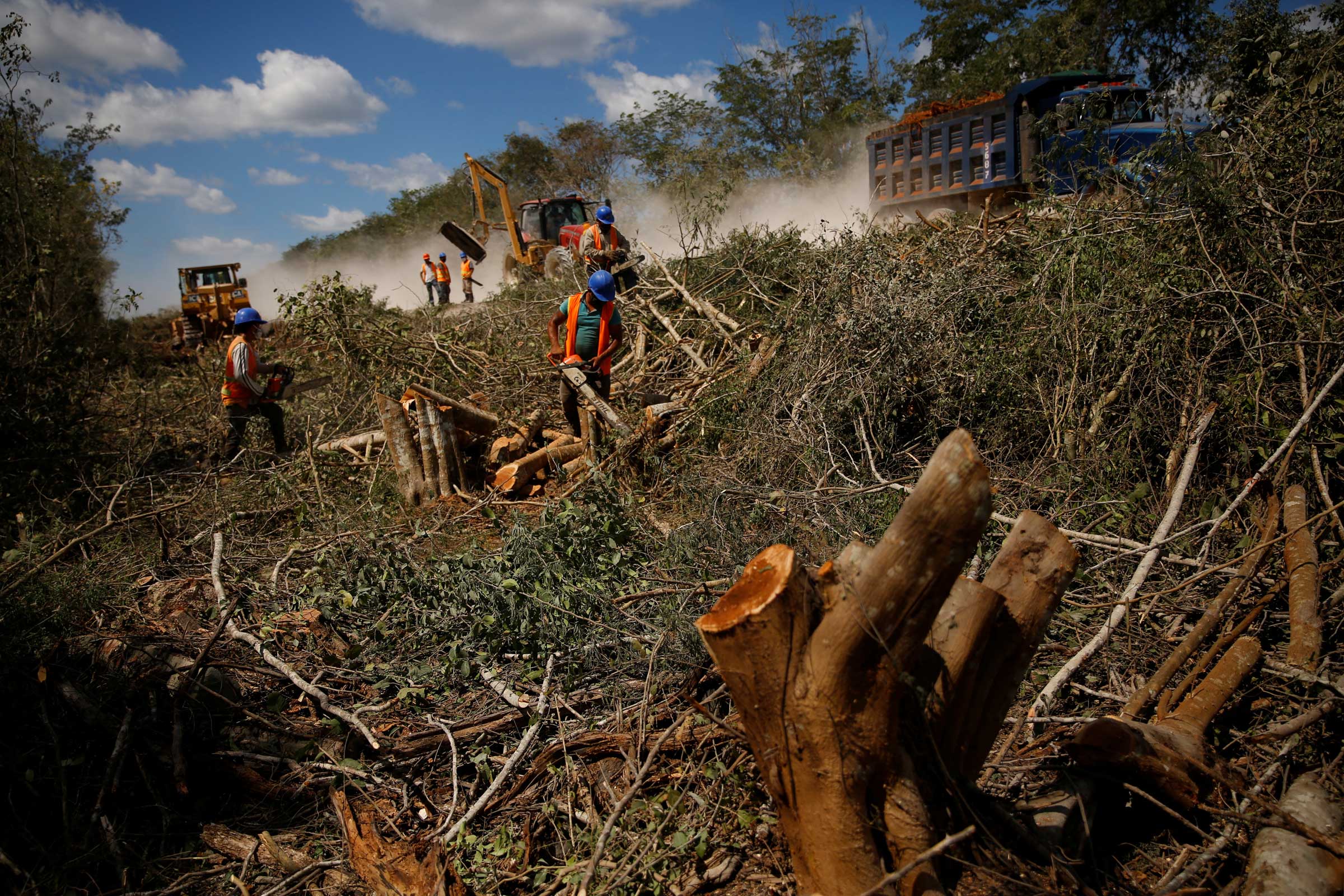
Crouching on all fours, wearing hard hats and knee pads, we shuffle and drag ourselves one by one through the small earthy hollow. When we reach the other side, a large cavern spreads out before us: countless stalactites hang suspended like icicles from the roof and mineral draperies dress large chalk columns. The floor beneath our feet is uneven, rising and falling like waves, before disappearing into a body of water at the other end.
There is no known public record of the enormous limestone cave we’re in, which is at least 100 meters (about 330 ft.) long, and somewhere underneath Tulum, a municipality in the Yucatan Peninsula known for its tourist beaches and Mayan ruins. It is one of an estimated 10,000 cenotes, water-filled sinkholes formed by the collapse of limestone, located across the Yucatan Peninsula in southeastern Mexico. It’s also one of several caves to have been unearthed since construction of the government’s Maya Train began—illegally—earlier this year.
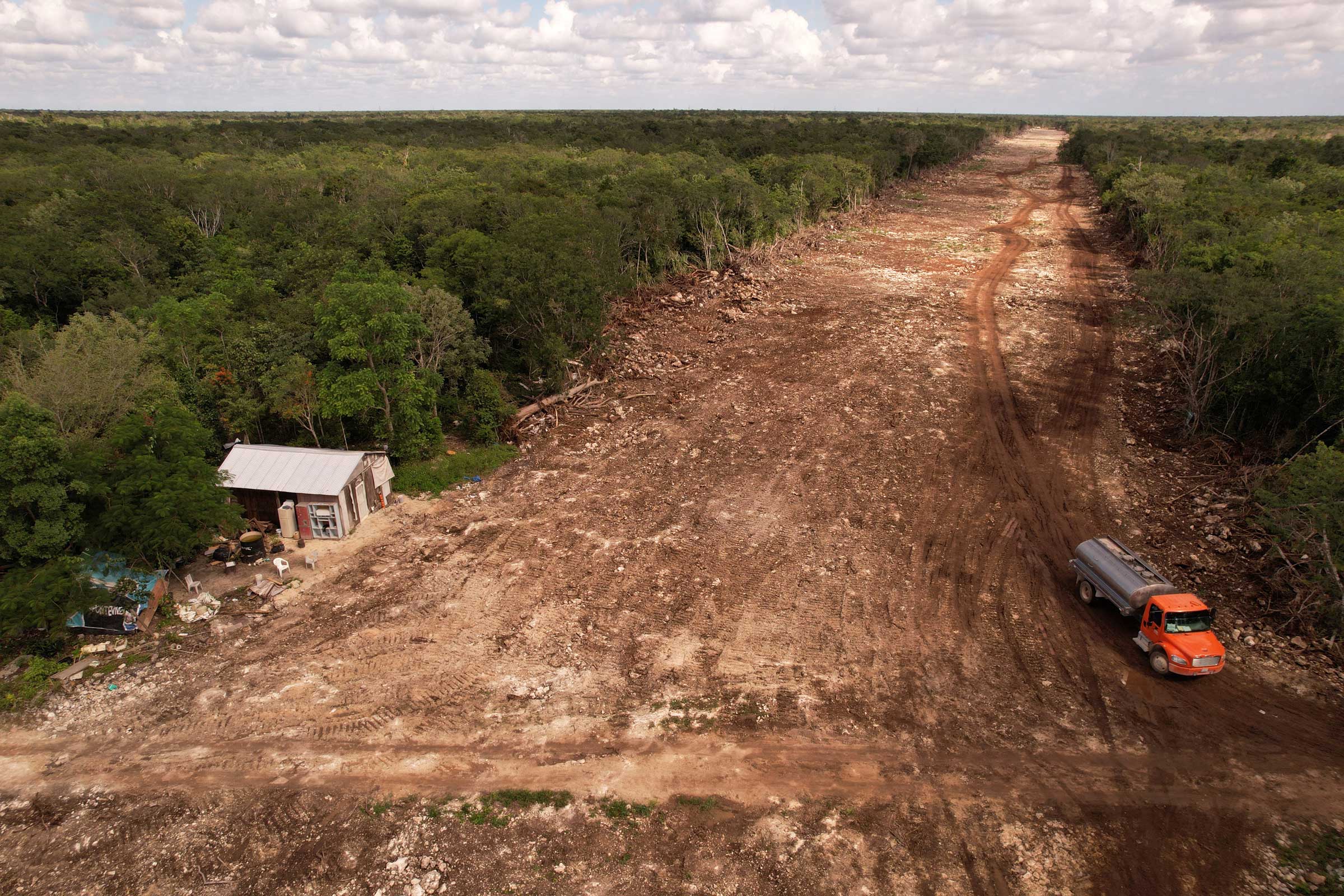
Designed in service of the tourism industry, the Tren Maya is an intercity railway line stretching 950 miles around the Yucatan Peninsula, in a rough loop around the states of Chiapas, Tabasco, Campeche, Yucatan, and Quintana Roo, connecting beach resorts with ancient Mayan sites. In total, the project entails the development of seven different tracks and 21 stations, and has been hailed by the government as an economic “detonator” for Mexico’s southeast, a historically poor and marginalized region.
The Maya Train has been touted as a jewel in Mexico’s infrastructure crown since it was first officially proposed in September 2018, following earlier suggestions to build a similar line. Supporters say the biodiesel-powered freight and passenger trains that will run the route will offer an environmentally-friendly alternative to road and air transport, delivering tourists and cargo to previously inaccessible locations.
But President Andrés Manuel López Obrador’s promises to protect the environment and keep project costs to a minimum have already fallen short. Untold environmental damage has already occurred, with huge swathes of forest cleared to accommodate the railway, while inadequate planning resulting in several route changes mid-construction has led to cost overruns and unexpected delays, despite early warnings from environmentalists, academics, and civil society groups long before work began. Failure to match project ambitions with a long-term strategic plan casts doubt on the Maya Train’s environmental credentials and economic viability. Yet experts say the worst may yet be to come. After all, the fragile cave system on which the Maya Train is being built forms part of the largest aquifer in the world, which flows under the Yucatan Peninsula, and is the source of drinking water for roughly 5 million Mexicans.
No water, no life
“Look,” says Elías Siebenborn, as he grabs at the ceiling and a handful of white rock crumbles in his hands. “This is what they’re building over.” Above us, what was once dense jungle has been reduced to a strip of exposed limestone, with stumps in place of where trees once stood.
Siebenborn is a member of Cenotes Urbanos, a group of amateur speleologists formed in 2018 to map and document the many unlisted cenotes in Playa del Carmen. Since work on the Maya Train began in 2020, it’s become a race against the clock to map as many of the undocumented caves affected by the railway line as possible. The idea is that, if they can put the cenotes on record, were officials to decide to fill in the cenotes and build over them, or should evidence of contamination emerge, the government will not be able to claim plausible deniability later on.
The cave we’re in lies beneath one particularly controversial segment of the Maya Train, referred to officially as “section five,” which connects the popular beach towns of Playa del Carmen and Tulum. The southern half of section five was originally planned to be built alongside an existing highway to minimize deforestation, but after the hotel lobby complained it was disrupting business, it was redirected. Now, a 68-mile-long scar cuts through the second-largest tropical rainforest in Latin America, one of the world’s most unique biological corridors.
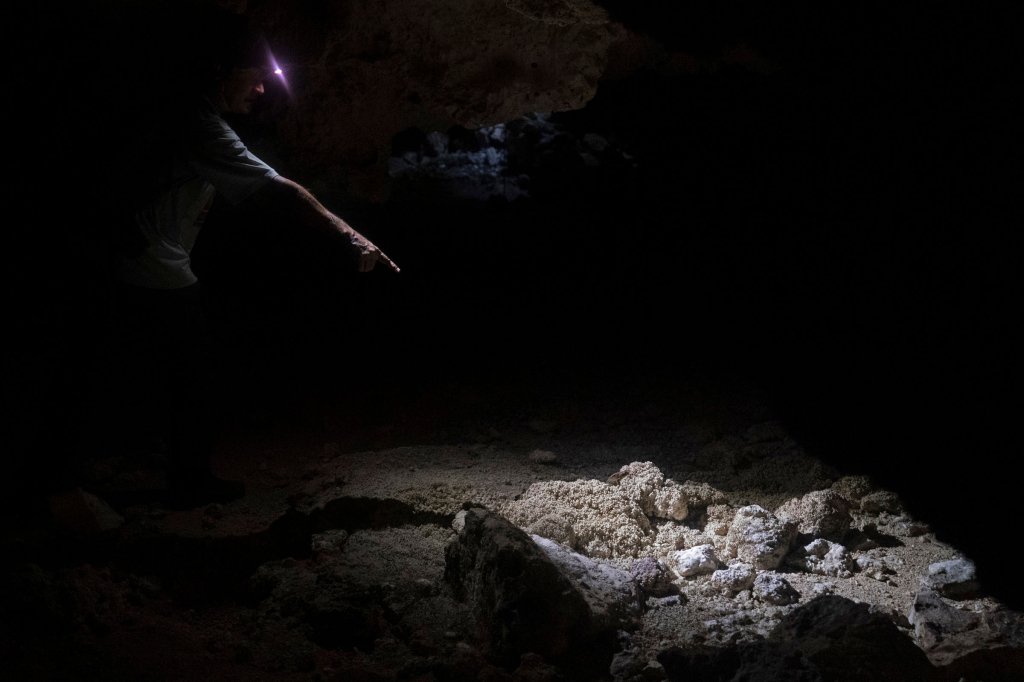
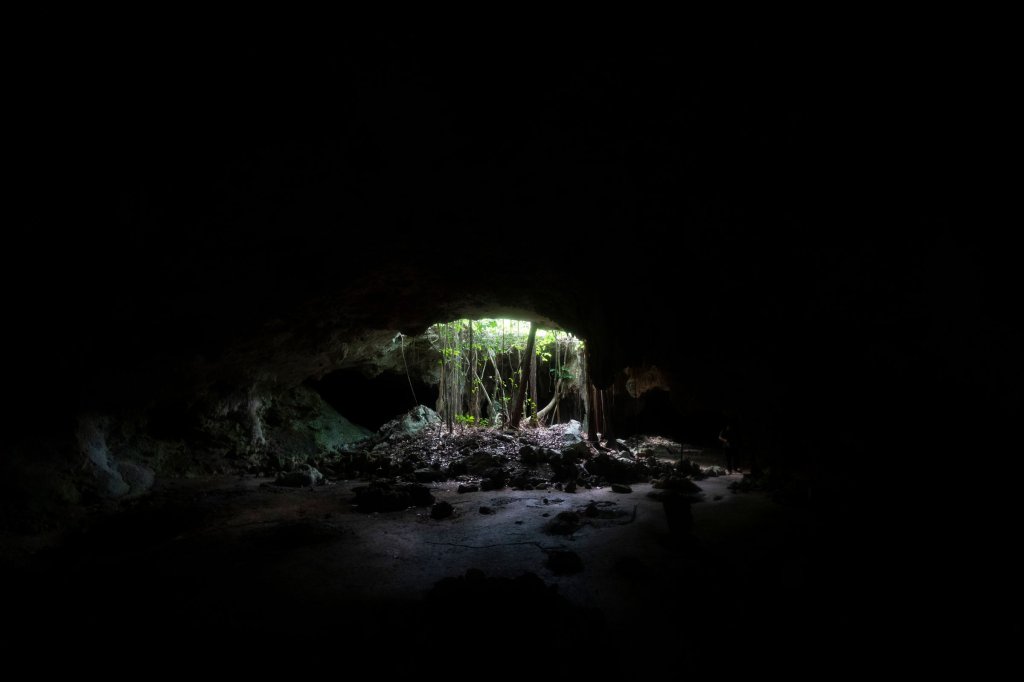
It also threatens the viability of the Great Maya Aquifer, which provides drinking water to millions of Mexicans. The aquifer is a relatively thin layer of freshwater that comes into direct contact with the surface through cenotes. And, unfortunately, cenotes across the Yucatan have in recent years become dumping grounds for waste resulting from rapid urbanization in the area. Playa del Carmen, until recently a sleepy fishing village, is one of Latin America’s fastest-growing cities, with a population that rose from 46,000 in 2000 to 304,000 in 2020. Urban planners and sanitation experts say that has led to illegal settlements popping up with no drainage or sanitary systems, resulting in contamination of the local water supply.
Indeed, over the past two decades, a combination of population growth, poor planning and political inaction in the Yucatan Peninsula has led to a 59% reduction in freshwater, indicating that its aquifers’ capacity to recharge their levels of water has been significantly altered by human pressure. According to Mexico’s national water authority CONAGUA, the region has 15 years to avert a water and sanitation crisis.
Pushing ahead with the Maya Train will only compound the problem, says Guillermo Christy, a water treatment consultant with 20 years experience in the region. That’s because the train will, in part, be built right on top of the aquifer’s most fragile points of contact with the surface. “In some places, the vaults of the caverns are just 20 or 60 centimeters from the surface,” Christy says. “It’s like wanting to build over eggshells.”
To construct the train infrastructure requires driving long piles deep into the ground, which poses a grave threat to this fragile ecosystem. “People don’t want to understand the fragility of our aquifers,” says Roberto Rojo, a biologist and founder of Cenotes Urbanos. “We’re heading for a water shortage.”
“Not a single tree”
In November 2018, López Obrador was a week away from taking up his post as president of Mexico, following his landslide victory over conservative Ricardo Anaya. López Obrador was to head up what many expected to be one of the country’s most left-wing administrations ever. Part of that was a commitment to the left’s environmental causes. For example, in an interview with journalist Carmen Aristegui, he repeatedly promised “not a single tree” would be cut down because of his flagship infrastructure project—the Maya Train.
Four years later, the government has acknowledged that 300,000 trees have been felled along section five alone. And that’s a fraction of the likely real damage; observers estimate that the real number is 9 million. “Of course, it depends on your definition of tree,” says Rodrigo Medellín, a researcher at the Institute of Ecology at Mexico’s National Autonomous University. “The soil there is nutrient-poor, plus they’re smack bang in the middle of hurricane territory, so they don’t grow as high or as wide as in other areas, but at 10-15 meters they’re already significantly higher than the botanical definition. Perhaps you’d get to 300,000 if you only count trees measuring at least 25 meters in height. But it’s categorically false.”
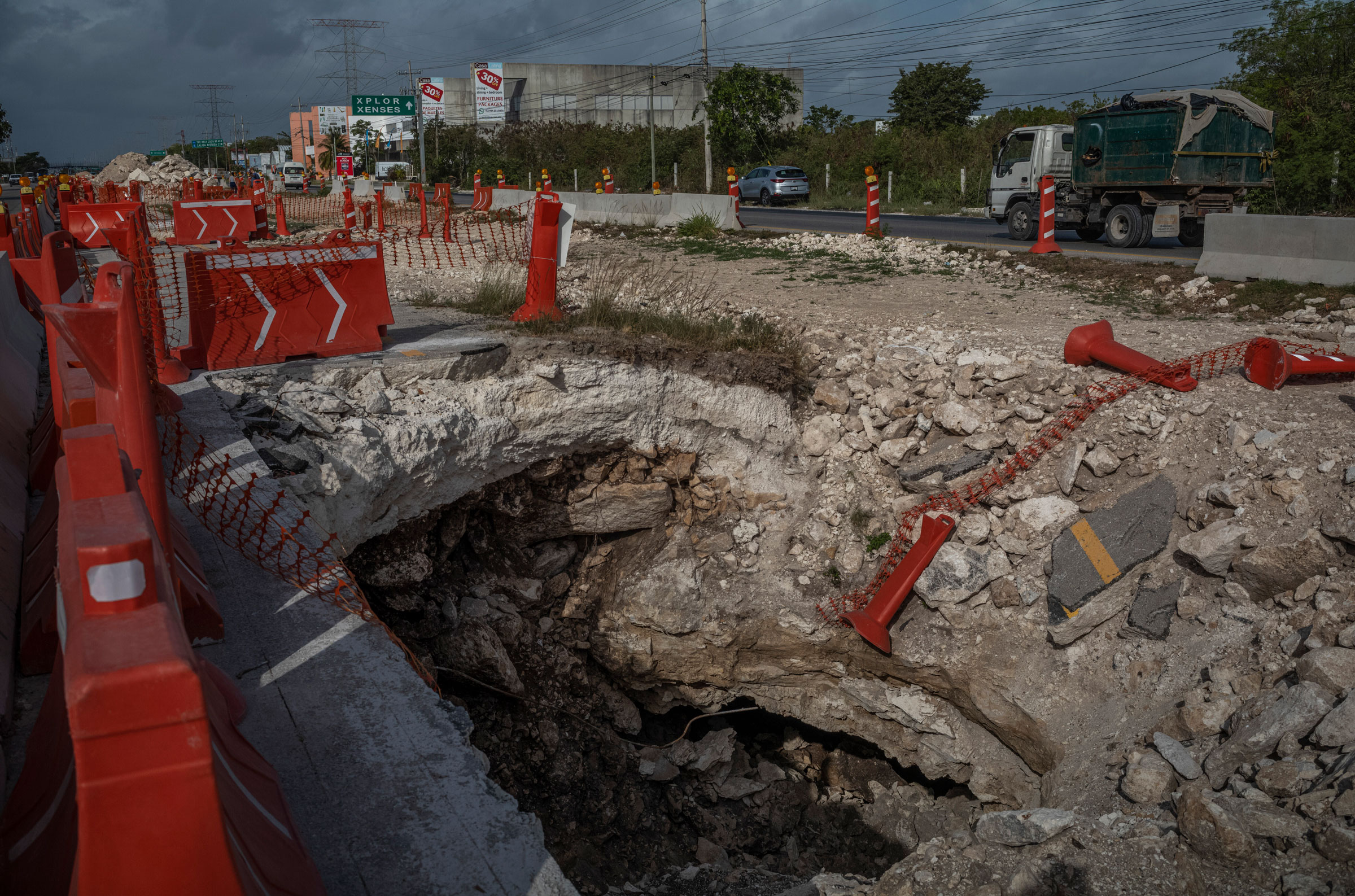
Normally, before any construction work in Mexico begins, an environmental impact assessment must be completed and submitted to the Ministry of Environment and Natural Resources (SEMARNAT). But in the case of Maya Train’s section five, no such study was done. That led critics to question the legality of the project.
“We consider there have been a number of human rights violations, including the right to a healthy environment,” says Gerard Alvàrez Armenta, a lawyer with the non-profit Mexican Center for Environmental Law. In early 2022, Armenta filed a lawsuit hoping to stop construction in section five, which he argued had begun despite there having been no environmental impact assessment. (The lawsuit was one of several filed since work on the project began.) In April, the presiding judge agreed, and suspended the project—but the suspension was short-lived. With campaigners demanding that the government release all relevant paperwork and correspondence, and the prospect of ongoing legal action threatening to derail the project, in July the president invoked a national security decree that enabled construction to continue despite the various judicial injunctions.
And then, just a month later, an environmental impact assessment pertaining to section five was finally published and approved by SEMERNAT, in record timing, leading many to question its reliability. Several environmental officials including three SEMARNAT directors who worked on the environmental impact assessment resigned from the mega-project, following mounting pressure to greenlight the project.
$20 billion and counting
Projects of a similar scale typically take around 15 years to execute, according to engineers who worked on the original plans; the Maya Train was meant to be completed in just four. No surprise then, that the budget for the Maya Train project, currently nudging $20 billion, has already cost taxpayers three times the government’s original estimate.
According to López Obrador’s government, the Maya Train has generated more than 140,000 direct and indirect jobs in the region, and will help create 715,000 additional jobs by 2030. It’s not easy to validate these government figures, and even less clear is how many locals will benefit, with migrant workers from across Mexico and farther afield being brought into the region to help with construction.

There do seem to be some direct financial rewards for those who go along with the government plan. In the small enclave of Jacinto Pat, in Tulum, 180 predominantly Mayan families received some $800,000 Mexican pesos ($40,000) each in exchange for surrendering a few kilometers of land to the rail line. President López Obrador has pointed to Jacinto Pat as evidence that the project has the support of locals, with residents appearing in a government video encouraging people “to get on board.”
But, while most Mayans I encountered across the state of Quintana Roo seemed initially supportive of the President’s signature project, after digging a little deeper, several admitted they had concerns. One couple, owners of a popular eatery, said many people were scared to voice any opposition because local politicians were López Obrador supporters. “To question is to ask for trouble,” they said. As small business owners, they said they feared reprisal in the form of extortion—on the rise in Quintana Roo—and sought to avoid making enemies of those in power.
One of Tulum’s most popular tourist attractions, a cenote park called Dos Ojos (“Two Eyes”), is managed by the Jacinto Pat community. Although the government agreed to divert the railway away from the main Dos Ojos cenotes, the new path will still pass over several other cenotes within the park.
“Do I personally want the Maya Train? No,” says one Jacinto Pat family figurehead, speaking anonymously out of concern for reprisal. “It will destroy the jungle, our home, and contaminate the cenotes, our life source.” But, he felt like he had no other choice. While the government has played down reports of forced evictions, insisting they were “consensual relocations” many families felt compelled to compromise to avoid a similar fate, he says. “And now we’ve taken the money, there’s nothing we can do.”
Deep inside Dos Ojos park, Gabriel Mazón is one of the few residents who refused to part with his portion of land. “I say this with all due respect: as a people, we have allowed ourselves to be bought,” he says. “But there is no support from indigenous people [for Maya Train]. If our ancestors could see what is being done in their name, they would die of sadness, knowing how they have been profaned, prostituted, and their culture and traditions used,” says Mazón. “We are little more than a brand or marketing slogan for the government. The people have already been paid off. There will be no more benefits. All we have left to wait for now is the invasion.”
More Must-Reads From TIME
- The 100 Most Influential People of 2024
- The Revolution of Yulia Navalnaya
- 6 Compliments That Land Every Time
- Stop Looking for Your Forever Home
- If You're Dating Right Now , You're Brave: Column
- The AI That Could Heal a Divided Internet
- Fallout Is a Brilliant Model for the Future of Video Game Adaptations
- Want Weekly Recs on What to Watch, Read, and More? Sign Up for Worth Your Time
Contact us at letters@time.com